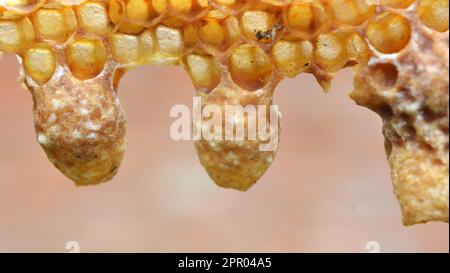 Not closed queen cell honey bee close up Stock Photohttps://www.alamy.com/licenses-and-pricing/?v=1https://www.alamy.com/not-closed-queen-cell-honey-bee-close-up-image547661917.html
Not closed queen cell honey bee close up Stock Photohttps://www.alamy.com/licenses-and-pricing/?v=1https://www.alamy.com/not-closed-queen-cell-honey-bee-close-up-image547661917.htmlRF2PR04A5–Not closed queen cell honey bee close up
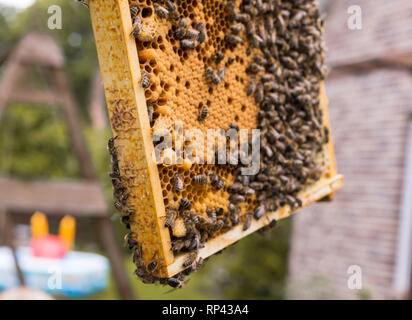 Frames of a hive with open and closed brood cells of a honeycomb. The bees practice brood care. Look in an open queen cell. Stock Photohttps://www.alamy.com/licenses-and-pricing/?v=1https://www.alamy.com/frames-of-a-hive-with-open-and-closed-brood-cells-of-a-honeycomb-the-bees-practice-brood-care-look-in-an-open-queen-cell-image237347660.html
Frames of a hive with open and closed brood cells of a honeycomb. The bees practice brood care. Look in an open queen cell. Stock Photohttps://www.alamy.com/licenses-and-pricing/?v=1https://www.alamy.com/frames-of-a-hive-with-open-and-closed-brood-cells-of-a-honeycomb-the-bees-practice-brood-care-look-in-an-open-queen-cell-image237347660.htmlRFRP43A4–Frames of a hive with open and closed brood cells of a honeycomb. The bees practice brood care. Look in an open queen cell.
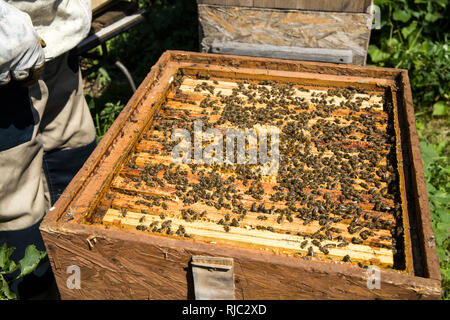 Frame with honey drawn from a beehive. Honeycombs in frame and bees. Choosing honey by beekeeper. Stock Photohttps://www.alamy.com/licenses-and-pricing/?v=1https://www.alamy.com/frame-with-honey-drawn-from-a-beehive-honeycombs-in-frame-and-bees-choosing-honey-by-beekeeper-image235064325.html
Frame with honey drawn from a beehive. Honeycombs in frame and bees. Choosing honey by beekeeper. Stock Photohttps://www.alamy.com/licenses-and-pricing/?v=1https://www.alamy.com/frame-with-honey-drawn-from-a-beehive-honeycombs-in-frame-and-bees-choosing-honey-by-beekeeper-image235064325.htmlRFRJC2XD–Frame with honey drawn from a beehive. Honeycombs in frame and bees. Choosing honey by beekeeper.
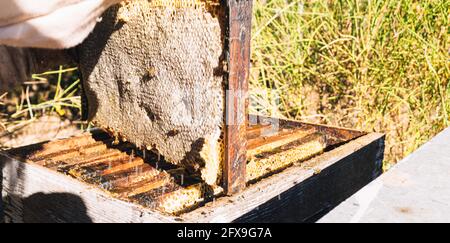 Detail of a honeycomb with bees on top of a hive showing the hexagonal and closed cells to contain the honey and wax as a food reserve for the insects Stock Photohttps://www.alamy.com/licenses-and-pricing/?v=1https://www.alamy.com/detail-of-a-honeycomb-with-bees-on-top-of-a-hive-showing-the-hexagonal-and-closed-cells-to-contain-the-honey-and-wax-as-a-food-reserve-for-the-insects-image429240206.html
Detail of a honeycomb with bees on top of a hive showing the hexagonal and closed cells to contain the honey and wax as a food reserve for the insects Stock Photohttps://www.alamy.com/licenses-and-pricing/?v=1https://www.alamy.com/detail-of-a-honeycomb-with-bees-on-top-of-a-hive-showing-the-hexagonal-and-closed-cells-to-contain-the-honey-and-wax-as-a-food-reserve-for-the-insects-image429240206.htmlRM2FX9G7A–Detail of a honeycomb with bees on top of a hive showing the hexagonal and closed cells to contain the honey and wax as a food reserve for the insects
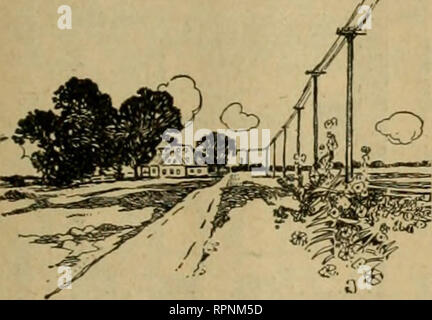 . American bee journal. Bee culture; Bees. Feb. 23, 190S. THE AMERICAN BEE JOURNAL. 155 frame has thus been injudiciously pulled out. After removing such a frame }U8t take a peep down into the hive and see for yourself. I prefer a bottom-bar less than an inch wide, otherwise I am greatly hindered in ray work when the combs are crowded with brood, bees, and honey. Wide bottom-bars have ruined many a fine queen-cell, killed thousands upon thousands of bees, and not a few queens. Mr. Learner has apparently bettered me in my argument relating to the advantages of the "closed-end" over th Stock Photohttps://www.alamy.com/licenses-and-pricing/?v=1https://www.alamy.com/american-bee-journal-bee-culture-bees-feb-23-190s-the-american-bee-journal-155-frame-has-thus-been-injudiciously-pulled-out-after-removing-such-a-frame-u8t-take-a-peep-down-into-the-hive-and-see-for-yourself-i-prefer-a-bottom-bar-less-than-an-inch-wide-otherwise-i-am-greatly-hindered-in-ray-work-when-the-combs-are-crowded-with-brood-bees-and-honey-wide-bottom-bars-have-ruined-many-a-fine-queen-cell-killed-thousands-upon-thousands-of-bees-and-not-a-few-queens-mr-learner-has-apparently-bettered-me-in-my-argument-relating-to-the-advantages-of-the-quotclosed-endquot-over-th-image237734041.html
. American bee journal. Bee culture; Bees. Feb. 23, 190S. THE AMERICAN BEE JOURNAL. 155 frame has thus been injudiciously pulled out. After removing such a frame }U8t take a peep down into the hive and see for yourself. I prefer a bottom-bar less than an inch wide, otherwise I am greatly hindered in ray work when the combs are crowded with brood, bees, and honey. Wide bottom-bars have ruined many a fine queen-cell, killed thousands upon thousands of bees, and not a few queens. Mr. Learner has apparently bettered me in my argument relating to the advantages of the "closed-end" over th Stock Photohttps://www.alamy.com/licenses-and-pricing/?v=1https://www.alamy.com/american-bee-journal-bee-culture-bees-feb-23-190s-the-american-bee-journal-155-frame-has-thus-been-injudiciously-pulled-out-after-removing-such-a-frame-u8t-take-a-peep-down-into-the-hive-and-see-for-yourself-i-prefer-a-bottom-bar-less-than-an-inch-wide-otherwise-i-am-greatly-hindered-in-ray-work-when-the-combs-are-crowded-with-brood-bees-and-honey-wide-bottom-bars-have-ruined-many-a-fine-queen-cell-killed-thousands-upon-thousands-of-bees-and-not-a-few-queens-mr-learner-has-apparently-bettered-me-in-my-argument-relating-to-the-advantages-of-the-quotclosed-endquot-over-th-image237734041.htmlRMRPNM5D–. American bee journal. Bee culture; Bees. Feb. 23, 190S. THE AMERICAN BEE JOURNAL. 155 frame has thus been injudiciously pulled out. After removing such a frame }U8t take a peep down into the hive and see for yourself. I prefer a bottom-bar less than an inch wide, otherwise I am greatly hindered in ray work when the combs are crowded with brood, bees, and honey. Wide bottom-bars have ruined many a fine queen-cell, killed thousands upon thousands of bees, and not a few queens. Mr. Learner has apparently bettered me in my argument relating to the advantages of the "closed-end" over th
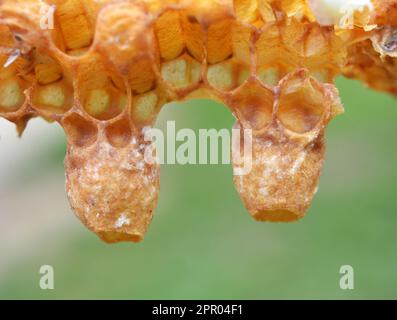 Not closed queen cell honey bee close up Stock Photohttps://www.alamy.com/licenses-and-pricing/?v=1https://www.alamy.com/not-closed-queen-cell-honey-bee-close-up-image547662053.html
Not closed queen cell honey bee close up Stock Photohttps://www.alamy.com/licenses-and-pricing/?v=1https://www.alamy.com/not-closed-queen-cell-honey-bee-close-up-image547662053.htmlRF2PR04F1–Not closed queen cell honey bee close up
 Beekeeper checks a frame of a hive. It shows open and closed cells of a breeding honeycomb and creeping bees. The finger points to an open queen cell Stock Photohttps://www.alamy.com/licenses-and-pricing/?v=1https://www.alamy.com/beekeeper-checks-a-frame-of-a-hive-it-shows-open-and-closed-cells-of-a-breeding-honeycomb-and-creeping-bees-the-finger-points-to-an-open-queen-cell-image237347657.html
Beekeeper checks a frame of a hive. It shows open and closed cells of a breeding honeycomb and creeping bees. The finger points to an open queen cell Stock Photohttps://www.alamy.com/licenses-and-pricing/?v=1https://www.alamy.com/beekeeper-checks-a-frame-of-a-hive-it-shows-open-and-closed-cells-of-a-breeding-honeycomb-and-creeping-bees-the-finger-points-to-an-open-queen-cell-image237347657.htmlRFRP43A1–Beekeeper checks a frame of a hive. It shows open and closed cells of a breeding honeycomb and creeping bees. The finger points to an open queen cell
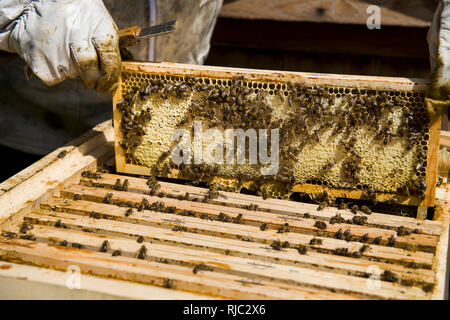 Frame with honey drawn from a beehive. Honeycombs in frame and bees. Choosing honey by beekeeper. Stock Photohttps://www.alamy.com/licenses-and-pricing/?v=1https://www.alamy.com/frame-with-honey-drawn-from-a-beehive-honeycombs-in-frame-and-bees-choosing-honey-by-beekeeper-image235064318.html
Frame with honey drawn from a beehive. Honeycombs in frame and bees. Choosing honey by beekeeper. Stock Photohttps://www.alamy.com/licenses-and-pricing/?v=1https://www.alamy.com/frame-with-honey-drawn-from-a-beehive-honeycombs-in-frame-and-bees-choosing-honey-by-beekeeper-image235064318.htmlRFRJC2X6–Frame with honey drawn from a beehive. Honeycombs in frame and bees. Choosing honey by beekeeper.
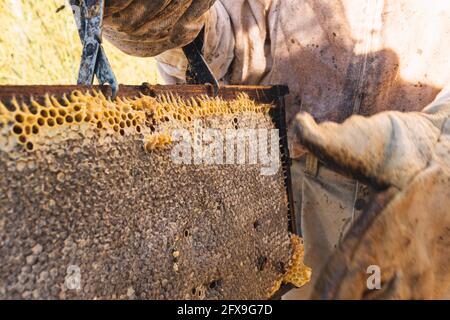 Detail of a beekeeper holding with tongs the wooden honeycomb of the bees closed to contain the honey and food necessary for the winter with selective Stock Photohttps://www.alamy.com/licenses-and-pricing/?v=1https://www.alamy.com/detail-of-a-beekeeper-holding-with-tongs-the-wooden-honeycomb-of-the-bees-closed-to-contain-the-honey-and-food-necessary-for-the-winter-with-selective-image429240209.html
Detail of a beekeeper holding with tongs the wooden honeycomb of the bees closed to contain the honey and food necessary for the winter with selective Stock Photohttps://www.alamy.com/licenses-and-pricing/?v=1https://www.alamy.com/detail-of-a-beekeeper-holding-with-tongs-the-wooden-honeycomb-of-the-bees-closed-to-contain-the-honey-and-food-necessary-for-the-winter-with-selective-image429240209.htmlRM2FX9G7D–Detail of a beekeeper holding with tongs the wooden honeycomb of the bees closed to contain the honey and food necessary for the winter with selective
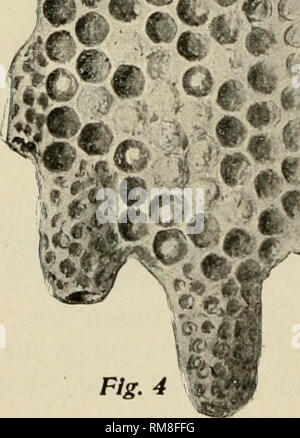 . Annual report of the Cornell University Agricultural Experiment Station, Ithaca, N.Y. Cornell University. Agricultural Experiment Station; Agriculture -- New York (State). Fig. I Fig. 2 Fig. 3 of her closed wings. (Fig. p. 78, i.) She has no pollen baskets or pollen combs on her legs, because it is not a part of her work to gather pollen or honey. The queen bee starts life as an ordinary worker egg; this o^gg is selected by the worker bees for development; the partitions of the cells around the cell in which it was laid are torn away and a large projection is built out over the top. (Fig. p. Stock Photohttps://www.alamy.com/licenses-and-pricing/?v=1https://www.alamy.com/annual-report-of-the-cornell-university-agricultural-experiment-station-ithaca-ny-cornell-university-agricultural-experiment-station-agriculture-new-york-state-fig-i-fig-2-fig-3-of-her-closed-wings-fig-p-78-i-she-has-no-pollen-baskets-or-pollen-combs-on-her-legs-because-it-is-not-a-part-of-her-work-to-gather-pollen-or-honey-the-queen-bee-starts-life-as-an-ordinary-worker-egg-this-ogg-is-selected-by-the-worker-bees-for-development-the-partitions-of-the-cells-around-the-cell-in-which-it-was-laid-are-torn-away-and-a-large-projection-is-built-out-over-the-top-fig-p-image236215716.html
. Annual report of the Cornell University Agricultural Experiment Station, Ithaca, N.Y. Cornell University. Agricultural Experiment Station; Agriculture -- New York (State). Fig. I Fig. 2 Fig. 3 of her closed wings. (Fig. p. 78, i.) She has no pollen baskets or pollen combs on her legs, because it is not a part of her work to gather pollen or honey. The queen bee starts life as an ordinary worker egg; this o^gg is selected by the worker bees for development; the partitions of the cells around the cell in which it was laid are torn away and a large projection is built out over the top. (Fig. p. Stock Photohttps://www.alamy.com/licenses-and-pricing/?v=1https://www.alamy.com/annual-report-of-the-cornell-university-agricultural-experiment-station-ithaca-ny-cornell-university-agricultural-experiment-station-agriculture-new-york-state-fig-i-fig-2-fig-3-of-her-closed-wings-fig-p-78-i-she-has-no-pollen-baskets-or-pollen-combs-on-her-legs-because-it-is-not-a-part-of-her-work-to-gather-pollen-or-honey-the-queen-bee-starts-life-as-an-ordinary-worker-egg-this-ogg-is-selected-by-the-worker-bees-for-development-the-partitions-of-the-cells-around-the-cell-in-which-it-was-laid-are-torn-away-and-a-large-projection-is-built-out-over-the-top-fig-p-image236215716.htmlRMRM8FFG–. Annual report of the Cornell University Agricultural Experiment Station, Ithaca, N.Y. Cornell University. Agricultural Experiment Station; Agriculture -- New York (State). Fig. I Fig. 2 Fig. 3 of her closed wings. (Fig. p. 78, i.) She has no pollen baskets or pollen combs on her legs, because it is not a part of her work to gather pollen or honey. The queen bee starts life as an ordinary worker egg; this o^gg is selected by the worker bees for development; the partitions of the cells around the cell in which it was laid are torn away and a large projection is built out over the top. (Fig. p.
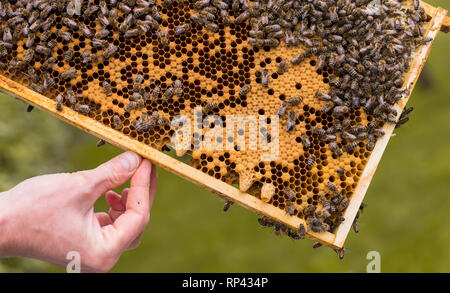 Frame of a hive with open and closed cells of a honeycomb and bees. queen cells for queen bee breeding Stock Photohttps://www.alamy.com/licenses-and-pricing/?v=1https://www.alamy.com/frame-of-a-hive-with-open-and-closed-cells-of-a-honeycomb-and-bees-queen-cells-for-queen-bee-breeding-image237347510.html
Frame of a hive with open and closed cells of a honeycomb and bees. queen cells for queen bee breeding Stock Photohttps://www.alamy.com/licenses-and-pricing/?v=1https://www.alamy.com/frame-of-a-hive-with-open-and-closed-cells-of-a-honeycomb-and-bees-queen-cells-for-queen-bee-breeding-image237347510.htmlRFRP434P–Frame of a hive with open and closed cells of a honeycomb and bees. queen cells for queen bee breeding
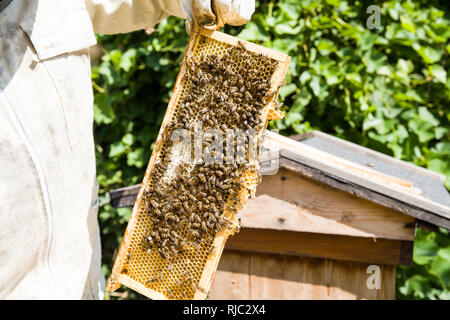 Frame with honey drawn from a beehive. Honeycombs in frame and bees. Choosing honey by beekeeper. Stock Photohttps://www.alamy.com/licenses-and-pricing/?v=1https://www.alamy.com/frame-with-honey-drawn-from-a-beehive-honeycombs-in-frame-and-bees-choosing-honey-by-beekeeper-image235064316.html
Frame with honey drawn from a beehive. Honeycombs in frame and bees. Choosing honey by beekeeper. Stock Photohttps://www.alamy.com/licenses-and-pricing/?v=1https://www.alamy.com/frame-with-honey-drawn-from-a-beehive-honeycombs-in-frame-and-bees-choosing-honey-by-beekeeper-image235064316.htmlRFRJC2X4–Frame with honey drawn from a beehive. Honeycombs in frame and bees. Choosing honey by beekeeper.